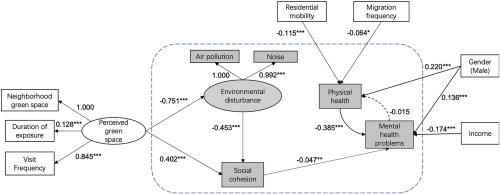当前位置:
X-MOL 学术
›
Environ. Res.
›
论文详情
Our official English website, www.x-mol.net, welcomes your feedback! (Note: you will need to create a separate account there.)
Using structural equation modeling to examine pathways between perceived residential green space and mental health among internal migrants in China.
Environmental Research ( IF 8.3 ) Pub Date : 2020-01-07 , DOI: 10.1016/j.envres.2020.109121 Min Yang 1 , Martin Dijst 2 , Jan Faber 3 , Marco Helbich 1
Environmental Research ( IF 8.3 ) Pub Date : 2020-01-07 , DOI: 10.1016/j.envres.2020.109121 Min Yang 1 , Martin Dijst 2 , Jan Faber 3 , Marco Helbich 1
Affiliation

|
BACKGROUND
Emerging evidence suggests that exposure to residential green space is beneficial for people's mental health along multiple pathways. It remains unknown, however, whether the complex pathways found for the general population also apply to internal migrants in China.
AIM
To examine the mediators of green space-mental health associations among migrants in the metropolis of Shenzhen, China.
METHODS
We conducted a cross-sectional survey among 591 migrants aged between 18 and 68 years in January-April 2017 in Shenzhen, a city facing a considerable inflow of rural-urban migration. Migrants' mental health was assessed using the 12-item General Health Questionnaire. Data on migrant's green space perception, migration characteristics, environmental disturbances, social cohesion, physical health, etc. were obtained through a questionnaire. Structural equation modeling was used to analyze the mechanisms underlying the green space-mental health association.
RESULTS
No direct effect of perceived green space on migrants' mental health was found. We did find, however, that perceived green space is significantly and indirectly related to mental health through reducing perceived environmental disturbance and enhancing social cohesion. Migrants' residential mobility presented a significant potential risk to migrants' physical health and might influence their mental health indirectly. A similar but only weakly significant health-threatening effect was found for migration frequency. Male and female respondents showed different patterns regarding their physical and mental health status. Migrants with higher personal incomes seemed to face a lower mental health risk.
CONCLUSIONS
Our findings suggest distinctive pathways through which residential green space could affect the mental health of internal migrants in China. Further studies in rapidly urbanizing areas are advised to evaluate green space-mental health relationships for specific population groups/subgroups with distinctive socioeconomic backgrounds.
更新日期:2020-01-07



























 京公网安备 11010802027423号
京公网安备 11010802027423号